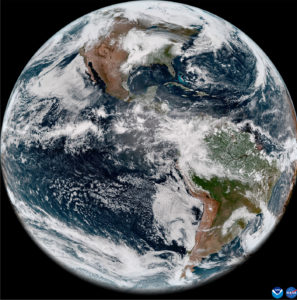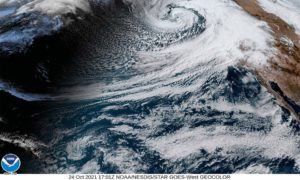We’re told to keep our climate and our weather separate. But Daniel Swain, a fourth-year graduate student climate scientist at Stanford, is happily mixing them up. His research focuses on the causes of persistent patterns in the atmosphere—like the ones that cause drought or exceptional rain in California—and how climate change might be affecting them. In his spare time, the 25-year-old Marin native runs the California Weather Blog, a must-read for weather nerds where he comments on statewide weather patterns and their big-picture causes. Swain is most famous, though, for something he did almost as an afterthought: He’s the one who gave the name “Ridiculously Resilient Ridge” to the pattern that’s being blamed for our three years of drought.
ERIC SIMONS: You coined the term “Ridiculously Resilient Ridge.” Where did that come from and what is it?
DANIEL SWAIN: It was tongue-in-cheek initially. I certainly didn’t expect it to spread as far as it has. But the primary motivator was to communicate effectively what was going on. The last “R” is fundamentally what it is. The ridge is a region of unusually persistent high atmospheric pressure over the northeastern Pacific Ocean, aligned along the west coast of North America. Ridiculously, well, that’s just a hyperbolic modifier, but certainly in a historical context it’s an unprecedented event. Is it resilient? Yes. It keeps returning. It’s not there all the time—it’s not the ridiculously permanent ridge. We have seen these individual storms break through. But if you average over a long enough period of time, there’s always a big red blob in that part of the Pacific for each of the past three winters, deflecting the North Pacific storm track to the north of its typical position. We keep getting these dry spells that last for weeks and then months during the rainy season.
ES: You got your undergraduate degree in atmospheric science at UC Davis and started your Ph.D. at Stanford four years ago, right as this unprecedented pattern just … appeared.
DS: It did coincidentally align with what my interests already were, looking at things at the weather-climate interface, but even more specifically, looking at persistent atmospheric events. These persistent patterns, particularly in a place like California, are the ones we need to watch out for. Because on one end of the spectrum, you get drought, like we’re having right now. On the other hand, if you see a winter season where it’s persistently the opposite—and the dynamics of that are not all that different, the whole pattern just needs to shift by a couple thousand kilometers or so—all of a sudden we’re on the persistently wet side of the storm track.
People often say California’s a land of extremes. In a statistical sense, that is actually kind of true. In terms of precipitation, for example, an average year is less likely than an above-average year—but then we occasionally get these incredibly prolonged dry spells.
ES: So you know what’s going on with the weather pattern, but how do you start to approach that as a climate research question?
DS: One of the first important things was to recognize the existence of this ridiculously resilient ridge. You can’t say the Ridiculously Resilient Ridge is or isn’t there by looking at a weather map for a particular day. You have to smooth over months or even years to see it. Because we’re not really interested in saying, “Are there days when there’s a huge mega-ridge over the west coast of North America?” Sure, there are. But it’s OK if we have a big ridge some days during winter, as long as on other days it’s not there. What matters is the average over a whole season. Are instances where this extreme high pressure area sticks around for a long period of time occurring more frequently, or will they occur more frequently in the future? Ultimately that becomes a more interesting question, because really that’s the question that’s relevant for knowing about the patterns that lead to drought and low precipitation in California.
It’s been argued that this ridiculously resilient ridge could just be internal atmospheric variability, popping up in the same spot over and over again by random chance. I think there’s a lot of evidence that it’s not random, that there’s a traceable physical cause. And that there’s almost certainly something going on in the ocean system that’s causing this to continually pop up, and that there may be something going on in the high latitudes that’s at least influencing the likelihood of seeing it. I don’t think anyone out there is arguing that the cause of the ridge and the drought is climate change, singularly. But you can ask about the likelihood of an event occurring. Then you go down the chain of potential causality, and you say, OK, the ocean’s important, the Arctic is important, snow cover, ice cover is important. Whatever it is, once you understand what the proximal physical causes are, you can then ask more targeted questions about the role of climate change in influencing these causes. That, ultimately, is how we’ll have a better understanding of how what’s going on is influenced by climate change. This is all fairly separate from the temperature question.
ES: So say more about the temperature question, then.
DS: The increase in the rate of warming between a few years ago and now is not something that will continue indefinitely. At some point we’ll have a year that is cooler than this year—although probably still above the long-term average. But what’s interesting is, these last couple of years have just been extraordinarily persistently warm. It’s not like we saw a couple of big heat waves and that skewed the mean. Just about every day has been above average, which tells you that your average is not really your average anymore. We have this shifting baseline.
Part of it is this ridge. The other part of this is we have these incredibly warm ocean temperatures, just phenomenally warm, nearshore along the California coast. Granted, we don’t have records going back that far for sea surface temperatures, but again, we’re continuously exceeding the existing records in many places. It’s one thing to get a couple-degree temperature anomaly in the atmosphere, but when you’re seeing three-, four-, five-degree warming in the ocean, that’s a huge amount of energy involved. Think about how much energy it takes to boil a pot of water: it’s a lot more than it takes to heat up the same volume of air by the same amount, that’s for sure. So think about how much energy is coming out of the ocean. It’s not surprising that California is so warm.
ES: You started Weather West in 2006, when you were in high school. Where were you drawing your information from?
DS: Largely the same places I do now. The federal government makes all this information available online. I can remember the first things I ever looked at on the Internet were weather maps. I remember connecting the dial-up modem, pissing off my parents because I was screwing up the phone line.
ES: It’s one of the great things about weather: how much information is out there and available. Most everyone relies on a filter like Weather.com or Weather Underground—but you realize, they’re all just looking at the same data to make their forecasts.
DS: It’s funny, because some unnamed senator from some state that isn’t California will say something like, “We don’t have to spend public money on weather services, Accuweather does a great job doing it by themselves.” Of course, Accuweather is essentially just repackaging federal government data. Accuweather doesn’t run satellites. They don’t have weather radar. They don’t have these earth observation platforms, or these very expensive computer models that produce the weather forecasts in the first place. Unless there’s some company out there that’s going to invest tens of billions of dollars in these things, this is definitely a governmental and multinational effort. These are data shared across nations, across borders, that sometimes transcend political boundaries that can’t be transcended in other realms. It’s hard to know a lot about the earth. Because it’s a big earth and it’s hard to see what’s going on at all times from our lonely perspective on the ground.
ES: Where did your interest in the weather come from?
DS: It was partly being outdoors. It was partly watching the big winter storms of the 1990s. There was one storm in particular in 1995 that really slammed the North Bay. There were all sorts of really wild conditions. Trees snapped in half; we lost windows at the house in San Rafael. That was pretty vivid; I remember being under my parents’ bed. It’s like a tornado experience even though it was Marin County.
I’ve always thought the atmosphere changes on a timescale that’s fun to watch. Granted, the last few years, it’s been warm and sunny a lot. But in general, it changes day to day, it changes hour to hour. The weather’s changing between now and 6 p.m. But also the weather is changing because we’re going into summer. But also the weather is changing because we’re emitting a lot of greenhouse gases and things are going to be different in 20 years, and 40 years. There are all these timescales on which you can ask interesting questions, and they’re never totally distinct from one another.
ES: When you do have some time off, where do you go to get outdoors?
DS: The last few summers I’ve tried to get out and do at least a brief road trip around the American West. I saw more rain in Arizona in July last year than I did the whole year in California. It’s nice to get away and go to a place with a pretty different climate, even though it’s not that far away. Even just going up to Yosemite and seeing what’s going on, meandering around Nevada.
ES: When you go somewhere with a different climate pattern, is this like when a birder who knows every bird in Northern California goes to the tropics? Or is it like, I don’t want to do this on vacation?
DS: No, it’s the opposite. Part of the reason I go to the Southwest in the summer is the monsoon season. There’s these awesome clouds, you get these awesome thunderstorms, this crazy weather you don’t get in California at any time of year. That’s part of the reason I go, to get out of the routine.
ES: You enjoy unusual weather.
DS: I enjoy unusual weather. I seek it out. It’s probably a good thing, at least for the sake of my dissertation, that California has had relatively stagnant conditions because it means I have fewer distractions. Of course, even when that’s the case, it’s turned into my dissertation. So take that with a grain of salt.





